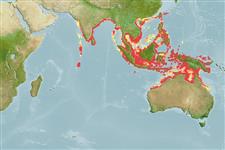Issue
Junior synonym Stolephorus bataviensis Hardenberg, 1933 is considered valid in CofF ver. 06 June 2023 following Hata et al., 2019 (Ref. 128121:11).
Environment: milieu / climate zone / depth range / distribution range
นิเวศวิทยา
เกี่ยวกับทะเล,น้ำเค็ม; น้ำจืด; กร่อย; สัตว์น้ำที่อาศัยและอพยพภายในทะเลเท่านั้น (Ref. 51243); ระดับความลึก 0 - 50 m (Ref. 189). Tropical; 25°N - 21°S, 71°E - 151°E (Ref. 189)
Indo-Pacific: western Indian Ocean (from Cochin and southern tip of India to Myanmar) and western Pacific (Thailand, Java Sea, the Philippines, probably Irian Jaya, if not also Papua New Guinea, south to Queensland; perhaps even more widespread). Its geographical overlap and similarity to S. insularis cast doubts on the several Indian studies of `insularis'. One of the commonest species of genus Stolephorus.
Length at first maturity / ขนาด / น้ำหนัก / Age
Maturity: Lm 8.4 range ? - ? cm
Max length : 9.4 cm SL เพศผู้/กระเทย; (Ref. 189); common length : 6.5 cm SL เพศผู้/กระเทย; (Ref. 189)
เงี่ยงครีบหลัง (รวม): 0; เงี่ยงครีบก้น 0; ก้านครีบอ่อนที่ก้น: 18 - 20. Belly with 5 to 7 small needle-like pre-pelvic scutes. Maxilla tip pointed, reaching to hind border of pre-operculum, the latter almost always convex, rounded. Pelvic fin tips only rarely reaching to below dorsal fin origin. Numerous black spots below level of eye and on tip of lower jaw, by which it is generally distinguished from other species; a dark patch behind occiput.
A pelagic, schooling species found in coastal waters. Caught mainly with seines (beach and purse), traps often using light, incidentally with bottom trawls. Marketed fresh, dried, dried-salted or made into fish meal, fish sauce fish balls and used as bait (Ref. 9822).
Wongratana, T., T.A. Munroe and M. Nizinski, 1999. Order Clupeiformes. Engraulidae. Anchovies. p. 1698-1753. In K.E. Carpenter and V.H. Niem (eds.) FAO species identification guide for fishery purposes. The living marine resources of the WCP. Vol. 3. Batoid fishes, chimaeras and bony fishes part 1 (Elopidae to Linophrynidae). FAO, Rome. (Ref. 9822)
IUCN Red List Status (Ref. 130435)
Threat to humans
Harmless
Human uses
การประมง: การค้า
ข้อมูลเพิ่มเติม
อ้างอิงการเพาะเลี้ยงสัตว์น้ำประวัติการเพาะเลี้ยงสัตว์น้ำสายพันธุ์พันธุศาสตร์ElectrophoresesอัตราพันธุกรรมโรคการแปรรูปNutrientsMass conversion
เครื่องมือ
Special reports
Download XML
แหล่งที่มาจากอินเตอร์เน็ต
Estimates based on models
Preferred temperature (Ref.
123201): 26.7 - 29.1, mean 28.4 °C (based on 1120 cells).
Phylogenetic diversity index (Ref.
82804): PD
50 = 0.5000 [Uniqueness, from 0.5 = low to 2.0 = high].
Bayesian length-weight: a=0.00501 (0.00289 - 0.00869), b=3.07 (2.92 - 3.22), in cm total length, based on LWR estimates for this species & (Sub)family-body (Ref.
93245).
ระดับชั้นอาหาร (Ref.
69278): 3.3 ±0.4 se; based on size and trophs of closest relatives
ความสามารถในการกลับคืนสู่ปกติ (Ref.
120179): ขนาดกลาง, เวลาต่ำสุดที่จะทำให้ประชากรเพิ่มขึ้นเป็น 2 เท่าใช้เวลา 1.4 - 4.4 ปี (K=0.16).
Fishing Vulnerability (Ref.
59153): Moderate vulnerability (42 of 100).
Nutrients (Ref.
124155): Calcium = 565 [193, 1,588] mg/100g; Iron = 2.77 [1.46, 4.87] mg/100g; Protein = 18.8 [17.0, 20.7] %; Omega3 = 0.296 [0.129, 0.704] g/100g; Selenium = 60.9 [23.8, 146.0] μg/100g; VitaminA = 26.9 [6.2, 109.4] μg/100g; Zinc = 3.05 [1.92, 4.83] mg/100g (wet weight); based on
nutrient studies.
